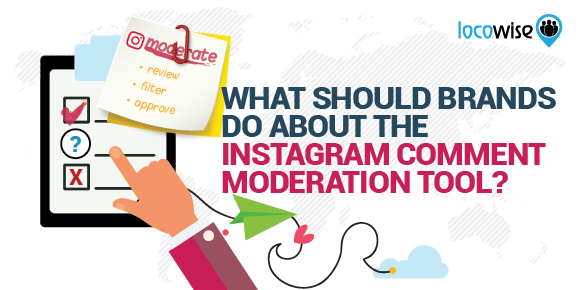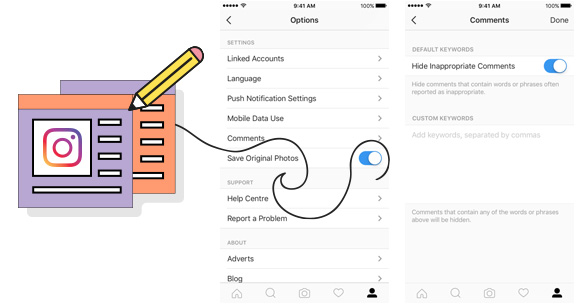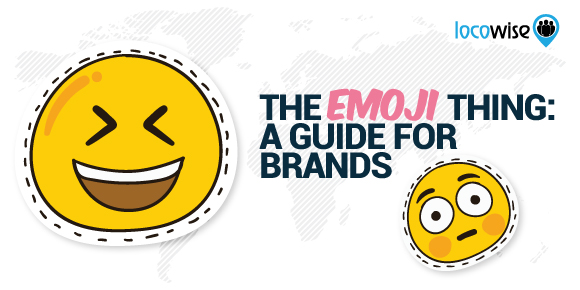What Should Brands Do About The Instagram Comment Moderation Tool?
Sahail Ashraf posted on 16 November 2016
Instagram is becoming more than just popular, and brands have been quick to jump on this particular train, with some excellent work completed by companies all over the world. But Instagram also has its ups and downs, and perhaps the best example of this is the move recently that the platform took to help with comments.
Instagram has empowered users, and brands for that matter, with a comment moderation tool that allows them to effectively censor the content that comes up in a feed. It has happened, and no one seems too concerned that censorship is now in the hands of the user. But what should brands do when it comes to using these new features?

First of all, what does the tool let you do?
Basically, you tap the gear icon on your profile and then the real meat of the operation comes into play. The comments tool comes up and you can list words that you find offensive. It’s pretty simple stuff, and is in addition to the usual moves Instagram allows you to make, such as reporting offensive comments and so on.
Here’s the deal from the source itself. We’re all for getting rid of offensive comments. It makes the world a better place. But can a brand honestly use this to its advantage?
The default setting
This is where the average user may feel a little uncomfortable. Instagram actually offers a default setting, where it blocks ‘words that users often find offensive’. If you’re a brand with a presence and a ton of comments, you may want to stop and think.
Okay, as a brand, you may be hip and cool and all that but some words simply should not be used in your feed. So you need to consider this. If you’re a brand that’s busy, it may be quite tempting to skip building your own word list and use the default setting because Instagram ‘has your back’. And this could be the case. It may be able to offer a list that meets your requirements and fits in with your brand voice perfectly.
Then again, it may not. We reckon that a brand that simply accepts the default setting on the filter will possibly maybe even alienate its audience. The simple option here is to check out that default setting and make sure it allows your audience to speak. Some things are acceptable to certain people. And that group of ‘certain people’ may well be your audience.
Take a look at your comments list if you’re super cautious. But we recommend not having it as your way forward. It’s nice to be in control, and it’s nice to think that your audience will have some freedom of speech.
There is room to move here, as always on social media. You can add more words and phrases as you customise your own list. A bit of work, sure, but it allows you to be in control. For brands, we definitely recommend taking advantage of the customisation feature. Going default could mean annoying your audience.

Mountains out of molehills
This is something that could most definitely happen. Consider the list very carefully, because comments exist for a variety of reasons. One of these reasons is to express a concern, or even to be angry. If you stop your customers from expressing themselves when they are a little bit cross, you could quite easily be turning them away.
Obviously, you can use the customisation list very carefully, to take out the words and phrases no one wants to see. But don’t go uber censorious, because this could mean that the ability to express frustration with your products and services (a perfectly acceptable phenomenon) is taken away from your audience.
Sometimes customer service is at its best, and most rewarding when it deals with problems. If you don’t allow your audience to use angry words, this could be a quick path towards having an audience that simply doesn’t want to be with you anymore.
To put it another way, making up is the best part about falling out.
Emojis
Life will simply stop happening online if emojis are banished. Okay, maybe not. But they’re everywhere. People now use them a lot. It’s that simple. In fact, emojis can actually increase engagement for a brand.
So if you look at the tool that Instagram has given you and you decide that certain emojis should be removed from all of your comments, you may want to think twice. We know, some of them are a little crude, but it is how people like to communicate.
Maybe it doesn’t even suit your brand, in your head at least. But your audience will want to use emojis, or at least have the option to use them. Taking all of that away from them can only lead to that same sense of alienation. Free speech (or free imaging) is vital in your relationship.
It’s also worth bearing in mind that emojis are not always equal. Some have a meaning that you may, quite justifiably, want to avoid. Others have double meanings, even triple meanings, in different communities. Put simply, remove emojis only if you are completely confident that you understand your audience. And even if you do, think about future customers.

So, to the future
Direct messages are not affected. So if someone really wants to complain or is desperate to congratulate you, their message will get through unharmed.
Instagram has gone on record to state that the main reason why they have introduced the tool is to protect those high-end users, celebrities and so on, who are always open to trolling and other unpleasantness. But brands have a chance now to be truly open with their users, and to maintain the kind of free speech ethic that allows for transparency and trust.
Our take? Customise as much as you are confident with. And we reckon that the more open you are, the better. In other words, don’t close doors that could lead to isolation. In these uncertain times online, it’s currently always best to be as accessible and honest as possible. Especially when you are marketing a product or service.
Do you want the metrics that matter? All day, every day? Grab a hold of your social media and use it intelligently. Take up a free trial of Locowise for fourteen days of the most comprehensive metrics around.




